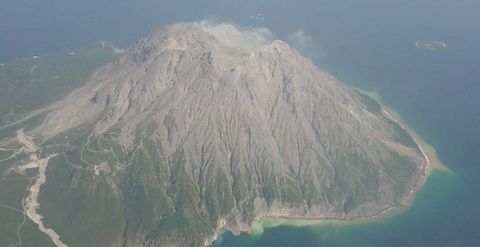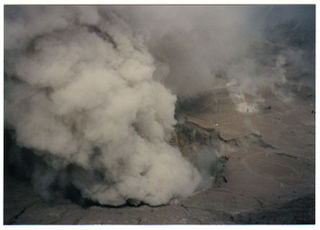Recent eruptions
火山研究解説集:薩摩硫黄島 (産総研・地質調査総合センター作成)
| Contents: Satsuma-iojima |
|---|
- Iodake of Satsuma-iojima volcano
Introduction
Satsuma-iojima has no documented records of eruptions before 1990s, but its fumarolic activities were mentioned in the Story of Heike and so it’s an active volcano with a long history of eruptions. It repeated small-scale eruptions with ash ejections from the summit crater of Iodake since late 1990s.
At the beginning of Showa period, a submarine eruption occurred about 2 km offshore to the east of Iojima forming Showa-iojima Island. This is the largest eruption within Japan in Showa period. According to activity classification of the Meteorological Agency, Iojima is ranked at A meaning the highest activity (Currently 13 volcanoes are A-ranked in Japan in 2008).
Recent eruptive activities
A crater about 400 m across with the depth of about 140 m exists at the summit of Iodake. Sulfur was mined in the area and within the crater from 12th century, and silica stone was mined from the same area until 1997. A vertical pit crater was formed within the summit crater since 1998 (To discriminate it from the summit crater, it is to be called ‘pit crater’), and frequently ejected ashes (See right photo: Ash ejection within the summit crater of Iodake). The ash consists of materials of altered ejecta deposited within the crater and no new magmatic materials were accompanied.
A large amount of high temperature volcanic gases have been discharged irrespective of ash eruptions from the summit crater. The discharge of the gases amounts to about 1,300 tons per day in terms of SO2. This is comparable to that of Sakurajima where frequent explosions are almost a daily phenomenon, suggesting high activity of underground magma even when no eruption is taking place.
Eruptive history during historical times
Among recent large eruptions were submarine eruptions which occurred in 1934-1935, and a new island, Showa-iojima, was created as a result where the depth of the sea used to be about 300 m. The volume of erupted magma was about 0.2 km3, one of the largest eruptions in Japan in Showa period and it was comparable to that of Heisei-Shinzan dome of Unzen Volcano in 1990-1995. This eruption occurred at the peripheral part of caldera wall between Iojima and Takeshima.
According to the Story of Heike, there were settlements in 12th century in Iojima, but no documented records are found describing eruptions. Scientific studies in recent years indicates, however, that there were explosive eruptions from the summit of Iodake 500-600 years ago accompanied with pyroclastic flows in western side of the mountain (See History of the volcano section).
(Hiroshi SHINOHARA)


